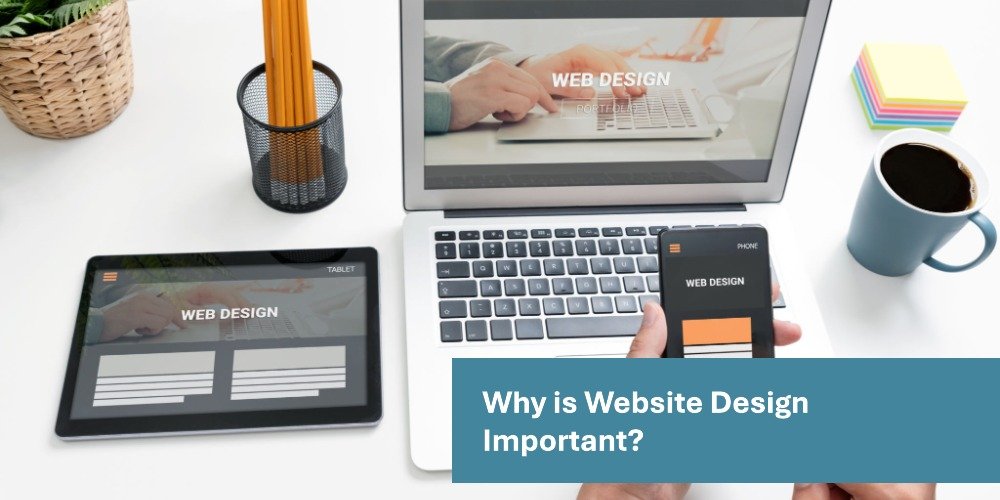Website design is important because it directly impacts user experience, first impressions, SEO performance, brand credibility, and conversion rates. If you are looking for a custom website design and development, then be sure to talk to our team, and we will guide you with the best custom website designs and development.
Importance of a Website Design
First Impressions Shape Trust
When someone lands on your site, they form an opinion in less than 0.05 seconds. A clean, professional, and easy-to-navigate design makes you appear trustworthy and keeps visitors engaged. If your site looks outdated or cluttered, you lose credibility instantly.
Improves User Experience (UX)
Good design focuses on usability and accessibility. Clear menus, readable fonts, responsive layouts, and consistent visuals help visitors find what they’re looking for quickly. If users struggle to navigate your site, they will leave, increasing your bounce rate.
Supports Search Engine Optimization (SEO)
Search engines like Google consider design-related factors such as mobile responsiveness, page load speed, and structured layouts. A well-designed site ensures faster performance and better indexing for better SEO, which helps you rank higher in search results.
Strengthens Brand Identity
Your website acts as your digital storefront. Consistent use of colors, fonts, and imagery reflects your brand’s personality and builds recognition. This helps visitors remember you and encourages repeat visits.
Boosts Conversions and Sales
A strategic design guides visitors toward actions like signing up, booking, or purchasing. Features such as clear CTAs (Call-to-Actions), optimized forms, and visually appealing product pages reduce hesitation and increase conversion rates.
Ensures Mobile Friendliness
With over 60% of web traffic coming from mobile devices, having a responsive design is no longer optional. A mobile-friendly website adapts to different screen sizes, providing a smooth experience whether on a phone, tablet, or desktop.
Builds Long-Term Business Growth
A strong website design reduces bounce rates, improves engagement, and enhances credibility, all of which contribute to higher customer retention and long-term revenue growth.
What are the Important Elements of a Good Website Design?
A good website design relies on several key elements: Usability, Visual Design, Content Quality, SEO Friendliness, and Mobile Responsiveness.
Essential Elements for Good Website Design
Usability (User Experience)
Usability is about how easy it is for visitors to interact with your website. A core principle is intuitive navigation. Visitors should be able to find what they’re looking for quickly, which means clear menus, a functional search bar, and a logical site structure. This also includes fast loading speed. Studies show that users often abandon pages that take more than 2-3 seconds to load. If your site is slow, you’re likely losing potential customers or readers. A simple, consistent layout also significantly boosts usability.
Visual Design
Visual Design focuses on the aesthetic appeal of your website. It sets the tone and builds trust. Important factors are a clean layout, high-quality images, and a consistent color palette and typography. The colors you choose should reflect your brand and be easy on the eyes. Good typography ensures readability. Use font sizes and types that are clear, typically at least 16px for body text on desktop. A strong visual graphic design immediately tells the user that you’re professional and credible.
Content Quality
Content Quality refers to the information you provide on your site. The content must be relevant, accurate, and valuable to your target audience. It should be easy to read, well-organized with headings and bullet points, and free of grammatical errors. Effective content clearly communicates your message and encourages visitors to take the desired action, whether that’s making a purchase, signing up for a newsletter, or reading another article. Clarity and conciseness are paramount here.
SEO Friendliness
SEO (Search Engine Optimization) Friendliness means designing your website so search engines (like Google) can easily find, crawl, and index your content. This involves using relevant keywords, properly formatted HTML (like H1, H2 tags), and having fast loading times (which overlaps with Usability). By ensuring your site is SEO friendly, you’re making it easier for people to discover you when they search online, which drives organic (unpaid) traffic to your site.
Mobile Responsiveness
Mobile Responsiveness is crucial, as the majority of web traffic now comes from mobile devices. Your website must look and function flawlessly across all screen sizes, from a small smartphone to a large desktop monitor. This isn’t just a design preference; Google heavily favors mobile-friendly sites in its search rankings. If your site isn’t fully responsive, you’re missing out on a huge segment of users and negatively impacting your SEO. You should ensure that buttons are easily clickable and text is legible without zooming on any device.

